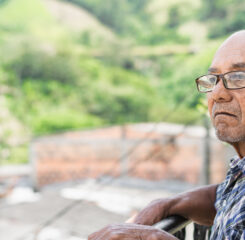First-Ever Data on LGBTQI+ Households and HUD Housing
HUD-assisted renter households are about as likely as all U.S. renter households to comprise LGBTQI+ households while housing insecurity metrics were higher for LGBTQI+ Black and Hispanic renter households than for their non-LGBTQI+ Black and Hispanic counterparts.
These and other data are from new research, posted on February 23 by HUD’s Office of Policy Development & Research, shed light on the housing experiences of the LGBTQI+ community, defined by the HUD researchers as lesbian, gay, bisexual, transgender, queer, intersex, and individuals whose orientations differ from those who identify as heterosexual and cisgender.
The new PD&R piece, Examining Housing Experiences by Sexual Orientation and Gender Identity, is made possible by the recent inclusion of sexual orientation and gender identity (SOGI) questions in the U.S. Census Bureau’s Household Pulse Survey. The Household Pulse Survey was initiated during COVID-19 to gather pandemic-era data on U.S. households. The frequently updated and revised data have become a treasure trove of information.
Because the Household Pulse Survey had already included data on race, ethnicity, and housing status, the new inclusion of SOGI data allowed PD&R to examine the intersection of these four characteristics. For the first time, HUD researchers were able to successfully link Household Pulse Survey SOGI data with HUD’s three largest programs (public housing, vouchers, and project-based multifamily housing). “[T]his analysis provides the Department’s first estimate of LGBTQI+ households receiving HUD assistance,” the PD&R researchers say.
“One key finding from this research is that renter households and HUD-assisted households demonstrate a similar prevalence of LGBTQI+ households. LGBTQI+ households make up approximately 15% of all U.S. renter households and approximately 12% of HUD-assisted renter households. This finding suggests that, at the national level, HUD’s housing programs may not pose a significant barrier to entry for LGBTQI+ households. More research is needed, however, to determine whether the take-up rate for LGBTQI+ households is consistent across different regions or market typologies (such as rural versus urban areas). More research is also needed to determine whether LGBTQI+ households who do receive assistance experience outcomes similar to those of non-LGBTQI+ households receiving assistance, such as in the length of assistance and the ability to access high-quality neighborhoods with HUD assistance,” the new research says.
PD&R also found that LGBTQI+ and non-LGBTQI+ households experienced similar rates of housing insecurity. Housing insecurity rates for these two populations were approximately the same as those in the general U.S. renter population.
However, when cross-tabulated with race/ethnicity categories, HUD found that housing insecurity metrics were higher for LGBTQI+ Black and Hispanic renter households than for their non-LGBTQI+ Black and Hispanic counterparts, while LGBTQI+ white renters exhibited housing insecurity rates similar to those of their non-LBGTQI+ counterparts. The researchers note the need for more research and caveats, like sample size and response rates, in the new brief.
“We hope that future research into the housing experiences of the LGBTQI+ community will help advance the cause of LBGTQI+ equality, mitigate the effects of generations of discrimination, and improve the lives of America’s sexual and gender minorities population,” the research concludes.
Read the new PD&R resource here.

Most Recommended
January 14, 2025
CAST’s Evolution: Reflection on What’s Ahead
February 21, 2025
 Improving Medicare Advantage
Improving Medicare Advantage
Recently Added
February 28, 2025
HUD to Cut Field Office Staff by May 18
February 28, 2025
HUD Terminates Fair Housing Rule
February 26, 2025



